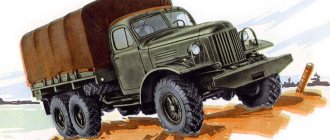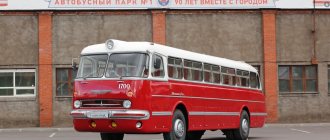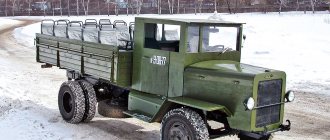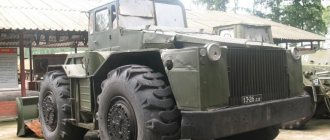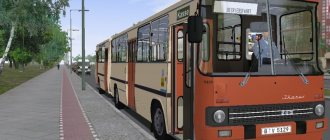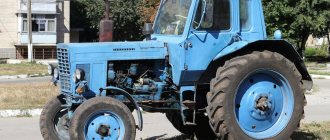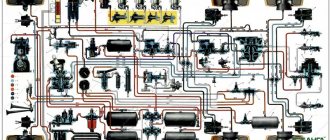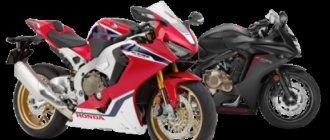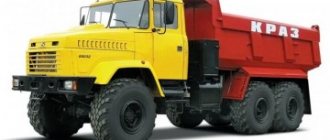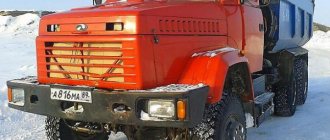KrAZ 214 is an off-road truck.
The history of the KrAZ 214 is closely connected with the Yaroslavl Automobile Plant. In 1951, Soviet engineers developed the YaAZ 214, which had a unique combination of technical solutions that were not used on any other truck in the USSR. The prototype for the equipment was the American car Diamond T 980, supplied to the country under Lend-Lease during the Great Patriotic War. From its “brother” from the USA, the YAZ 214 received a transmission, chassis components and frame. The YAZ-206 engine developed for the car was a copy of the GMC 71-6 unit, the license for which the USSR bought from General Motors. The rear bogie, wheels and cabin for the YaAZ 214 were taken from the YaAZ 210G, assembled by analogy with another American truck. Testing of the equipment, which started in 1951, was completed successfully, but the start of production had to wait another 5 years, during which a number of improvements were made to the design.
Serial production of the YaAZ 214 began in 1957, but after 2 years the production of trucks was taken away from the Yaroslavl Automobile Plant, transferring it to the Kremenchug Automobile Plant. This is how the KrAZ 214 model appeared. In its original form, it was produced until 1963, after which an improved version appeared - KrAZ 214B. Its production ended in 1967; the KrAZ 255B truck replaced the equipment in the plant’s lineup.
The YaAZ 214 (KrAZ 214) model was conceived as a tractor for particularly heavy trailers. The car could transport enormous loads (up to 50 tons as part of a trailer) on roads with different surfaces and off-road. The equipment was used in the oil and gas industry and in the army.
Modifications
- YaAZ 214 - the basic version, the production of which was carried out in 1957-1959 in Yaroslavl (a total of 1265 vehicles were manufactured);
- YaAZ 214Sh7 - a special tractor with modified units, a power take-off and a closed body (created in 1956);
- KrAZ 214 - a model of the Kremenchug Automobile Plant, differing from the YaAZ 214 only in the absence of a bear on the hood (produced in 1959-1963);
- KrAZ 214B - an improved version of the KrAZ 214 with hydraulic telescopic shock absorbers (front suspension) and 24 V mains voltage (produced in 1963-1967).
The KrAZ 214 was the base chassis for a number of military vehicles, including:
- heavy mechanized bridge (TMM);
- onboard tractor for transporting heavy artillery crews;
- tactical missile launch system of the 2K5 "Korshun" complex;
- pontoon bridge park (PMP);
- tow trucks of various types (E-305V/EOV-4421).
KrAZ-214: the beginning of the journey
Work on the project of a new cargo tractor began in 1950. The vehicle was assigned the index YaAZ-214, which in 1959, after the transfer of production of trucks from Yaroslavl to Kremenchug, was changed to KrAZ-214. The designers were required to create a vehicle capable of transporting cargo of various categories and types, as well as personnel in any conditions, regardless of the quality of the road and the degree of roughness of the terrain. In addition, the vehicle's capabilities had to include the ability to tow heavy trailers. In general, the army needed a universal and reliable transport.
Specifications
Dimensions:
- length – 8575 mm;
- width – 2700 mm;
- height (without awning/with awning) – 2880/3180 mm;
- wheelbase – 4600 (+1400) mm;
- ground clearance – 360 mm;
- front track – 2030 mm;
- rear track – 2030 mm;
- turning radius – 14000 mm.
The curb weight of the truck is 12,300 kg, the total weight is 19,570 kg. Off-road, the car can transport loads weighing up to 7000 kg. The weight of the towed trailer varies from 5,000 to 50,000 kg, depending on the quality of the road surface and the density of the load.
The KrAZ 214 can accelerate to 55 km/h, and with a trailer – up to 40 km/h. The power reserve is 850 km. The maximum surmountable ascent is 30 degrees, the ford depth is 1000 mm.
Wheel size – 15.00-20.
Engine
The KrAZ 214 was equipped with a 2-stroke in-line diesel unit YAZ-206B, which was a modernized version of the YAZ-M206 unit installed on YAZ 210 series vehicles.
There were no intake valves in the engine; purge windows located in the middle of the liners were used to fill the cylinders with air. In this case, the role of intake valves was played by pistons; pump injectors were used instead of a fuel pump. The special design of the YaAZ-206B contributed to a significant reduction in vibration in comparison with 4-stroke analogues. The repair process of the unit was made easier due to the fact that the cylinder liners were easily removable.
The engine design included water-oil heat exchangers in which water cooled the oil. The engines were equipped with 2 types of starting heaters: an electric torch device (for heating the air entering the cylinders) and a unit with a fuel injector (for heating oil and water).
Characteristics of the YAZ-206B engine:
- working volume – 6.98 l;
- rated power - 205 hp;
- maximum torque – 765 Nm;
- compression ratio – 16;
- number of cylinders – 6;
- cylinder diameter – 108 mm.
The KrAZ 214 was considered as a tractor for heavy loads, and therefore was equipped with a powerful unit. The YaAZ-206B provided excellent traction, but this advantage had a downside. Fuel consumption per 100 km was 70-135 liters, depending on the load level. The car was equipped with 2 fuel tanks, each of which held 255 liters of fuel.
The 1950s were a time of great transitions in the history of the Soviet automobile industry. During this period, one can count more than a dozen cases when the well-functioning production of certain cars was transferred from one plant to another. The reasons were different: in some places duplicate production was created to reduce the transport deficit in the country, in others capacity was freed up for the development of new types of cars. The case of the Yaroslavl Automobile Plant stands apart, where they decided to curtail the assembly of trucks altogether in favor of a radical expansion of the production of diesel engines. The plant itself was renamed from an automobile plant to a motor plant (YaMZ instead of YaAZ), but in return the Kremenchug Automobile Plant appeared on the map of the USSR, where the same cars began to be produced under the new KrAZ brand. KrAZ - 214 The Yaroslavl Automobile Plant was one of the oldest in the USSR: they began building trucks of their own design just a year after they started producing AMO-F-15 trucks in Moscow. But the volume of car production in Yaroslavl has always remained very, very modest, ranging from several hundred to 3.5 thousand units per year. It was the lack of capacity that became the reason why, by 1951, the production of two-axle trucks of the YaAZ-200 family was completely withdrawn from Yaroslavl to Minsk - otherwise the plant would not have been able to start producing the heavy “three-axle” YaAZ-210 that the country needed so much. But their production volumes remained so modest that they did not even cover the needs of the army alone, not to mention the national economy. The YaAZ-210 is the car for which the production of two-axle YaAZ-200 trucks was transferred from Yaroslavl to Minsk. When, by the end of the 1950s, the prospect of developing the newest family of V-shaped diesel engines with 6, 8 and 12 cylinders, created by the NAMI Institute, loomed before the Yaroslavl Automobile Plant , it became obvious: it is simply impossible to further develop both engine and automobile production simultaneously within the existing areas! As a result, the government made a decision: to specialize the Yaroslavl site only in the production of power units, increasing its design capacity to at least 70 thousand diesel engines per year by the mid-1960s. YaMZ-236 is the first diesel model from a new family, mastered in Yaroslavl after the cessation of automobile production. They decided to transfer the assembly of cars to a third-party enterprise, carrying out its complete re-equipment. The Kremenchug Combine Harvester Plant, which until now had been producing various agricultural equipment, was chosen as such an enterprise. He was supposed to begin assembling trucks according to Yaroslavl documentation and from Yaroslavl (at first) components already in 1959. And in 1965, after the completion of the production localization process, the production volume of trucks in Kremenchug needed to be increased to 15 thousand units per year, almost five times exceeding the YAZ figures. The corresponding decisions were formalized by Resolution of the CPSU Central Committee and the USSR Council of Ministers No. 442 of April 17, 1958. YAZ-214 is the founder of a new family of trucks, developed in Yaroslavl in 1956. It was this family that was to be transferred to Kremenchug. At the very first stage of rebuilding the combine plant into an automobile plant, which received the new abbreviation “KrAZ”, it was necessary to expand the area by approximately 20 thousand square meters, install 1540 units of pressing, welding and metal-cutting equipment. Along with the technological re-equipment of existing workshops, new divisions were created: frame and body, experimental, thermal. As for the engineering personnel, their backbone was mainly formed from among the employees of the design and experimental department of YaAZ, who moved from Yaroslavl to Kremenchug for permanent residence. KrAZ-222 is the model with which the history of automobile production in Kremenchug began. The first cars, still mainly from imported components and parts, were assembled in Kremenchug on April 10, 1959. They were two KrAZ-222 dump trucks - almost exact copies of the Yaroslavl YaAZ-222 dump trucks. The second model mastered towards the end of the year was the KrAZ-214 all-wheel drive trucks. And in 1960, the continuous production of KrAZ-221 truck tractors and KrAZ-219 flatbed trucks began. KrAZ-221 truck tractor At the same time, the assembly of the first batches of vehicles at KrAZ was carried out in very difficult conditions: the process of re-equipping the plant was still in full swing, the production of components was being mastered, and a new workforce was being formed. All this was compounded by regular disruptions in the supply of a number of parts from subcontractors and an acute shortage of personnel, especially in design departments. In this regard, it is not surprising that the plant initially did not fulfill the planned tasks for assembling cars. For example, at the end of 1959, only 394 dump trucks and 25 all-wheel drive vehicles were produced in Kremenchug, which was about 80% of the plan. Things were similar in 1960, which ultimately led to the removal of the first director of KrAZ, D.N., from his post. Palacheva. A more experienced “anti-crisis” manager I.M. was appointed in his place. Prikhodko, transferred from a similar position at another Kremenchug enterprise - the Kryukov Carriage Works. Under his leadership, work at KrAZ really soon returned to normal: in 1964, the plant had already surpassed the bar of 10 thousand vehicles per year and continued to actively gain momentum. All-wheel drive KrAZ-214, assembled in Kremenchug The transfer of production of Yaroslavl trucks - in many ways very imperfect - to a new location could be used as a convenient reason for carrying out deep modernization. But this did not happen, and documentation for the serial YaAZ trucks of the 1959 model was transferred to Kremenchug, along with all the problems already identified in operation. During the moving process, only decorative changes were made. First of all, the emblem on the hood was adjusted: instead of the Yaroslavl figurine of a bear, a simplified cast handle appeared on Kremenchug cars, stylized with red and blue coloring to resemble the flag of the Ukrainian SSR. The one mounted in the upper part of the radiator trim instead of the previous “YaAZ” plate received a similar red-blue background. And on the sides of the engine compartment they introduced additional decorative plates with the inscription “Dnepr-214” - this is what it was originally planned to call the Kremenchug trucks. True, the name “Dnepr” did not catch on: the trucks of the Kremenchug Automobile Plant received the KrAZ brand, and the mentioned plates were soon removed from production vehicles.
But the cabin itself remained the same - wood-metal, made using 1930s technology and already outdated at the time of its appearance. Initially, it was developed specifically for the YaAZ-214 all-wheel drive vehicles, and later adapted to other Yaroslavl trucks with a 6x4 wheel arrangement. The design of this cabin was frame-panel, with a frame made of wood - more precisely, from multi-layer aircraft plywood with special impregnation. The outer cladding of the pre-assembled plywood “cage” was carried out with steel panels, fastened with ordinary screws. The advantage of this type of cabin was the low cost of production preparation: it did not require either heavy presses or complex stamping equipment. But the downside of cheapness is low durability: during operation, the wooden frame was subject to loosening. The screw connections of the frame and skin ties required regular tightening, tinting and gluing of the plywood: otherwise the cabin quickly lost its tightness and collapsed. By the way, the cabs of earlier trucks of the YaAZ/MAZ-200 and YaAZ-210 families were also built using the same technologies, however, the YaAZ-214 type cab was primarily distinguished from all of them by its increased width by 335 mm and the presence of a heating system with air flow on both halves windshield with warm air. Moreover, each of the halves was mounted in its own frame and could be folded up to improve ventilation or blow out dust from the cabin when driving on dirt roads. Two-stroke diesel engine of the YaAZ-206 series From today’s perspective, in the design of the YaAZ-214 and KrAZ-214 trucks, you can find many unusual technical solutions that are now completely unused. Take, for example, the engine: it was a 6-cylinder diesel engine YaAZ-M206B, operating on a two-stroke cycle. It had no intake valves at all: air was supplied to the cylinders using a mechanical supercharger through windows in the liners, and fuel injection was carried out by pump injectors. Compared to four-stroke diesel engines of that time, it had a surprisingly high liter power: it produced 205 forces from only 7 liters of displacement. But the downside of this boost was gluttony: even the control fuel consumption of the KrAZ-214 was 65 l/100 km, and the actual operational one, especially when working with a trailer, easily went beyond 100 liters. In addition, Yaroslavl two-stroke diesel engines were noisy and smoky, and their high heat load did not have the best effect on their service life. But there was still no other suitable engine in the arsenal of the Soviet automobile industry of that time... KrAZ-214 at VDNKh in 1961 Another feature characteristic exclusively of the YaAZ-214 and KrAZ-214 trucks was an unusual transmission. The single-disk clutch, together with a spring servo amplifier in the mechanical drive for its release, a 5-speed gearbox and double gearboxes of the truck axles in “all-wheel drive” vehicles were unified with similar components of trucks with a 6x4 wheel arrangement. However, it was not possible to use the same gearbox for the front drive axle: due to the vertical arrangement of the main gear stages, it would inevitably rest against the engine sump. Therefore, the front gearbox for the “two hundred and fourteenth” was borrowed... from the rear axle of a ZIS-150 truck, subjected to minor modifications! And in order to compensate for the resulting difference in axle ratios, the transfer case provided an additional reduction in the front axle drive. Serial KrAZ-214 in real operation The pneumatic system of the “two hundred and fourteenth” also deserves attention. It consisted of two circuits, but only the first of them belonged to the working brake system. The second circuit was auxiliary and was used to operate the windshield wipers and sound signal, to inflate tires, but most importantly, to drive the pneumatic power steering. Unlike the classic hydraulic booster, it did not come into operation immediately, but only at the moment the steering wheel was turned with a force of more than 10–11 kg, after the spring switch was activated. Moreover, in the pneumatic booster line there was also a manual tap, which the driver had to close completely when driving on flat roads without sharp turns. The reason for this recommendation was that the performance of the compressor, originally borrowed for the YAZ-214 from the ZIS-150 truck, was simply not enough to provide long-term compressed air to both the brake system and the power steering. Converted KrAZ-214 in Moscow At one time, the wheels used on the YaAZ-214 (the same as on the Minsk all-wheel drive MAZ-502) were considered innovative for the Soviet automobile industry: discless, with a collapsible Trilex-type rim, consisting of three sectors. These wheels were extremely labor-intensive to manufacture, and during operation they were subject to wear of the locks and joints. But with a special mounting blade, it was much easier to remount the Trilex than a traditional disc wheel. In addition, the wheel with a Trilex rim was lighter. By the way, the standard tires for the KrAZ-214 were low-pressure tires of the YA-90 model with dimensions 15.00–20, and the weight of a fully assembled and inflated wheel reached 205 kg. Having dealt with the basic issues of organizing automobile production and having established the rhythmic operation of the conveyor, the Kremenchug Automobile Plant began the ongoing modernization of its now trucks. There was a lot of work to be done in this direction, since reliability has never been the strong point of YaAZ vehicles. All-wheel drive trucks received especially a lot of criticism. The accumulated operating experience showed that already in the second year of operation, these machines showed multiple defects, including those of an obvious structural nature. The consistently problematic unit was the Zisov front axle gearbox, the strength of which did not correspond to the loads circulating in the transmission. The rear suspension quickly failed, in which the balancer axis wore out and the main spring leaves wore out at the point of contact with the support platforms on the bridge beams. Many defects appeared on the brake drums, and there were frequent cases of cracks appearing in the frame side members. The YAZ-M206B diesel engines never achieved sufficient durability, and the standard YA-90 tires usually wore out in just 17-18 thousand km, without reaching the warranty mileage. In addition, the vehicle's cross-country ability on these tires, especially in the absence of an inflation system, has increasingly become considered insufficient. KrAZ-214 and KrAZ-214B in actual operation in Yakutia A separate list of complaints was collected by the small-sized traction winch, mounted between the frame side members under the front part of the platform and driven by a separate cardan transmission from the power take-off. It had a cable 55 meters long, which could be extended both forward and backward through a system of guide rollers, and was supposed to develop a pulling force of about 12 tons. With such parameters, its capabilities should have been sufficient to pull previously uncoupled trailers and artillery systems off-road, and to pull out other stuck vehicles, and to carry out its own evacuation. Moreover, in especially severe cases, the traction force of the winch could be doubled through the use of a pulley chain applied to each machine. However, in practice, quite often, even before the winch had time to develop maximum force, the safety pin in its drive was cut off. In addition, there were problems with the uniformity of the cable laying on the winch drum (which could lead to a break), as well as with the cable jamming during release. KrAZ-214 and KrAZ-214B in real operation in Yakutia All these complaints were fully confirmed by control tests of two production KrAZ-214 vehicles at the main customer. The commission's verdict was strict and unsightly: due to a large number of defects, both cars were declared unable to pass the tests! This circumstance served as a catalyst for accelerating modernization work, and already at the end of 1962, modified KrAZ-214B trucks began rolling off the assembly line of the automobile plant. This index was assigned to cars in which a complex of several measures to refine the design was implemented, which were introduced into production during the year. KrAZ-214B on virgin snow There were several key innovations. For example, back in December 1961, a new front axle appeared on the “two hundred and fourteenth”, which in terms of differential, gears, shafts and bearings became as unified as possible with the axles of the rear bogie. From this point on, the gear ratios of the gearboxes in all three axles became the same (8.21), as well as the gear ratios to the output shafts for each of the axles in the transfer case. Visually, the unified front axle on the car is most easily identified by the shape of the axle flanges, which have become the same as those of the trolley axles (and not flat, like the ZIS-150). On the left is the hub part of the front axle of the YAZ-214 and KrAZ-214, on the right is the hub part of the front axle of the KrAZ-214B. The second most important change in the modernized vehicles was the new rear suspension. After a revision of the kinematics of its operation, the trajectory of movement of the ends of the spring leaves relative to the supporting platforms changed from sliding (friction) to rolling. This required moving the centers of rotation of the reaction rods. Along the way, the spring ladders were strengthened and the diameter of the tie bolts was increased, and the cross-section of the spring leaves took the form of a curved trapezoid instead of a straight one. As a result, wear on the rear suspension has been dramatically reduced, and the ride has improved. Serial KrAZ-214B The third innovation was the electrical equipment system, switched to 24-volt voltage instead of 12-volt to facilitate starting a cold engine. The number of batteries on the car has not changed: as before, there were four of them, each with a capacity of 128 Ampere-hours. They were placed in pairs in two boxes on the left and right steps of the cabin. But the battery connection scheme changed: inside the boxes, the batteries were now connected in series, and then both pairs were connected to each other in parallel. Accordingly, all the main electrical equipment (starter, generator, relay regulator, etc.) have changed. Certain design elements of the KrAZ-214B vehicles, of course, were refined in a later period of time. For example, instead of the short-lived YA-90 tires, the Dnepropetrovsk Tire Plant created a new 18-ply low-pressure tire YA-190, which increased the vehicle's cross-country ability, especially on soft soils. KrAZ-214B in airfield service Almost immediately after the start of production, KrAZ-214 began to be supplied abroad, and for a long time the export vehicles did not have any original designations. Only in 1967 were technical specifications issued for individual export modifications of the KrAZ-214BE (for temperate climates) and KrAZ-214BT (for the tropics). The first of them was characterized, by and large, only by higher quality of assembly and painting and more stringent acceptance criteria. But tropical trucks differed in the types of paints and varnishes and rubber products used, as well as special impregnation of the wooden frame of the cab and the extension sides of the platform, which protected them from being eaten by termites. KrAZ-214B chassis at a car repair shop in the GDR. A total of 2,867 flatbed trucks and chassis of the KrAZ-214 series were exported to 36 countries. The largest batches entered the armed forces of India (852 units), UAE (524 units), East Germany and Syria (309 units each). In addition, a number of vehicles not taken into account in these statistics were also delivered abroad with various weapons systems. Taking into account the fact that the total number of KrAZ-214 family trucks that came off the assembly line was 32,870 units, we can assume that about 10% of these vehicles were exported. Production of the KrAZ-214B ended in 1969, when the assembly of the new KrAZ-255B all-wheel drive vehicles, mastered at the end of 1967, “gained momentum”. A page about the KrAZ-214BE from the catalog of V/O "Avtoexport" Thus, on the scale of the Soviet Union, the circulation of trucks of the KrAZ-214 family remained quite modest, and therefore it is not surprising that the number of copies that have survived to this day can be counted on one hand. Five of them are kept in museums in the post-Soviet space. The oldest example is in the collection of the Kremenchug Automobile Plant itself: it is an onboard KrAZ-214, restored in 2005 after being discovered in storage in one of the military units of the Armed Forces of Ukraine. Only a few details, such as tires, transfer case or front axle, do not correspond to the declared 1960 release. Restored KrAZ-214 from the factory collection Another running copy of the flatbed truck, only in the KrAZ-214B modification, is present in the museum collection of Mosgortrans. And in the collections of the Military Historical Museum of Artillery, Engineering Troops and Signal Corps in St. Petersburg, two samples of special equipment on the KrAZ-214B chassis have been preserved: the BM-25 combat vehicle of the 2K5 “Korshun” tactical missile system and a link of the TMM heavy mechanized bridge. Finally, in the closed exhibition of the Museum of Fuel Service of the Armed Forces of the Russian Federation, the TZ-5 army tanker on the KrAZ-214B chassis survived until the present decade. KrAZ-214B from the collection of Mosgortrans, which at some time they tried to pass off as YAZ-214 - they even put a corresponding figurine of a bear on the hood Source 2 Source 1 Text: Nikolay Markov
Device
The KrAZ 214 with a 6 by 6 wheel arrangement and large dimensions was rather an “exotic” on public roads. The frame of the machine was installed on straight parallel side members and had 5 cross members and linings to strengthen the structure. The front leaf springs were mounted on brackets with rubber pads at the ends of the springs. The front suspension, mounted on the frame, had lever-type hydraulic shock absorbers with vertical rods adjustable in length. The rear axles received a balanced leaf spring suspension, complemented by 15-leaf packages. The front tow bar allowed the KrAZ 214 to function in rigid coupling with other tractors for towing heavy trailers.
The car was the first in the USSR to be equipped with segment-type discless wheels. The deep rim included 3 segments. Initially, the equipment was equipped with tires with a “reversible” tread, the lugs of which provided optimal traction in any direction. In the early 1960s, tires with herringbone tread began to be installed on the KrAZ 214.
The cardan transmissions were not unique and consisted of 5 shafts, 2 of which received an intermediate support on the rear axle. The latter had a 2-tier double final drive. It is noteworthy that the KrAZ 214 in profile resembled a plane taking off, which was due to its design features. Otherwise, the unit would begin to hit the “single-story” gearbox in the event of sagging of the front suspension.
The KrAZ 214 was equipped with a single-plate clutch with a central conical pressure spring. There were no damper springs on the clutch driven disc. The car received a 5-speed gearbox from the YaAZ 210 (5 forward speeds, 1 reverse speed) with synchronizers in all gears except first. The transfer cases were a three-dimensional spatial stepped system weighing almost 400 kg. They consisted of 4 crankcases combined into a block.
The braking system contained a 2-cylinder compressor and brake drum mechanisms. An innovation in the KrAZ 214 was pneumatic piston cylinders. The parking brake was a drum brake and practically copied a similar element of the YaAZ 210 model, but had large pads.
The equipment received a 12-volt electrical system with 4 6ST-128 batteries, combined into 2 groups.
The KrAZ 214 was equipped with a hood-type cab and externally resembled models of the mid-1950s. The cabin consisted of a wooden frame with angles for reinforcement and was sheathed on the outside with sheets of steel. The car was equipped with a new instrument panel, the rest of the elements were almost entirely “migrated” from their predecessors. The interior was lined with special cardboard. The driver's seat was supposed to be adjustable in the forward-backward direction. The KrAZ 214 model was one of the first to receive a switchable pneumatic power steering to make driving easier.
The birth of a truck
During the Great Patriotic War, Americans supplied their equipment to the USSR under Lend-Lease. One of these vehicles was the 12-ton Diamond T 980 truck. It became the prototype of the developed Soviet YaAZ-214 vehicle.
From the American he got: the frame, transmission and chassis elements. The engine, despite the fact that it was labeled YaAZ-206, was a copy of the GMC 71-6, the license for which was purchased by the USSR, again from the American General Motors. It was a two-stroke diesel engine with six cylinders.
The YAZ-210G, by the way, also assembled according to American technology, “gave” the domestic truck a rear bogie, a center differential and a transfer case.
The prototype was equipped with a cabin and wheels from the same YaAZ-210, and in 1951 it was presented for testing. Having successfully passed them, the new truck was recommended for mass production. However, it took another 6 years for the car to be brought to perfection. Serial production of trucks was organized only in 1957, and two years later all production was taken away from YaAZ and transferred to the assembly line of the Kremenchug Automobile Plant.
